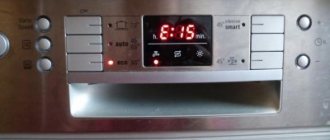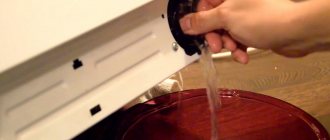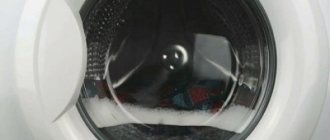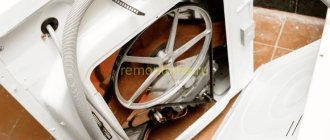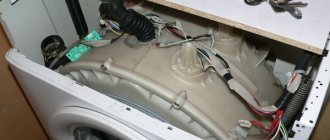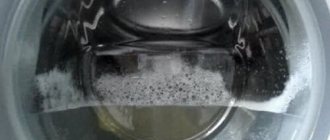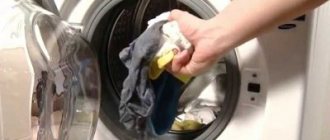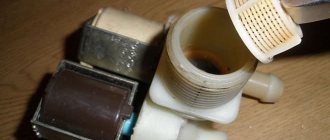Kandy washing appliances are automatic machines that rarely cause trouble to their owners. But even with such washing machines, malfunctions may occur.
One of the typical problems is drain failure. Not only equipment failure, but also blockage can lead to a malfunction.
Why the Kandy washing machine does not drain water and how to fix the problem, we will tell you further.
Reasons for the failure
There may be several reasons why the drain did not go through:
- sewer blockage in the apartment;
- clogged components that are directly involved in draining water from the tank (pipe, drain filter, hose, pump);
- pump breakdown;
- breakdown/failure of the control module;
- break and other disturbances in the electrical circuit of the washing machine itself;
- power outage during draining or washing.
You can make sure that no drainage has occurred by checking that the water remains in the tank. Without draining, the machine does not switch to spinning and work stops. A failure may also be indicated by an error code on the display or blinking indicators.
How is water heated?
The water entering the tank is heated by a heating element. The tubular element is built into the bottom of the washer. The main problem with heaters is that they become covered with a thick layer of scale, after which their thermal conductivity is impaired.
If your region has hard tap water, it is better not to save money and install a softener filter at the entrance to the apartment or directly in front of the inlet hose of the machine. Due to this, it will be possible to protect the “insides” of the machine from scale.
The more often you start high-temperature washing, the faster the heating element will fail. Therefore, there is no need to constantly “rinse” things in hot water heated to 60°C-90°C. This will not be useful for either clothing or equipment.
Diagnostics of the Candy washing machine
It is better to start searching for the reason why the waste water has not been drained with the simplest and most accessible components for inspection. According to statistics, the most common problem of not draining water from the washing machine tank is a clog.
To make it easier to find the reason for stopping work without draining, error codes that the device itself displays on the display:
- E03 – water draining error, in which the liquid either does not leave the tank at all or drains very slowly;
- E06, E15 – control module failure;
- E20, E22 – problem with the pressure switch (clogging, malfunction of the control module, etc.).
Even the device issuing a specific error code requires additional diagnostics. This is because multiple nodes may be involved in the failure.
In devices without a display, information about a failure is provided by a series of flashing lights . The number of light signals corresponds to a specific code.
Pay special attention to the belt
Inexpensive Candy models have two weak points - the engine and the drive mechanism. Both the design itself and the quality of these parts are not delightful. According to statistics, already in the first year of operation, one out of 14 washing machines begins to have problems with the motor, drive belt or tachometer.
It is precisely because of the failure of these elements that the machine may stop with a full tank of water and not begin spinning. It is better to start diagnostics with the drive belt - it is the easiest to get to. The algorithm of actions will be as follows:
- Turn off the power to the washing machine, close the inlet valve, disconnect the drain and inlet hoses;
- place the washing machine so that you have free access to all sides of the body;
- Unscrew the bolts securing the rear wall, remove the panel;
- inspect the internal components of the machine.
First, pay attention to the drive belt. Perhaps he even fell off the “wheel” and is lying below
Then it will immediately become clear why the machine stopped working.
If the belt is tight, rotate the large pulley first to the right, then to the left. The “wheel” must rotate with a certain force, and the elastic tension must be sufficient. If it bends or moves, it will have to be replaced.
A poorly tensioned drive belt does not allow the motor to spin the drum to the required speed. The washing machine cannot spin. This leads to a system error that causes the machine to freeze in the middle of the cycle.
Some craftsmen on the forums suggest not changing the belt, but saving money by tightening the engine mount to move the pulley a few millimeters. Due to this, the desired degree of elastic tension is achieved. However, this solution only saves for a few months, and then the problem recurs.
Ways to solve the problem
Diagnosing the condition of a Kandy washing machine that does not drain very often requires partial disassembly of the case, but some problems can be fixed on your own, without calling a technician. If you need to disassemble the case, then the first thing you should do is drain the water from the tank, turn off its supply to the washing machine and unplug the plug from the socket.
The sewer is clogged
A clogged drain in an apartment may cause the Kandy washing machine to not drain water. You can check if this is the case by disconnecting the drain hose from the place where it taps into the pipe and throwing its free end into the sink or bathtub.
If water begins to flow out of the device, then the problem is a clogged sewer. Cleaning the pipes in the apartment will help solve the problem. You can do this on your own or by calling a plumber.
Drain hose
It is necessary to inspect the drain hose along its entire length . If there is squeezing, for example, by furniture pushed close together, or a kink that interferes with the outflow of water, the hose should be released and straightened. If the hose surface is significantly deformed or there is a leak, the part is replaced with a new one.
If the hose is clogged, you will need to partially disassemble the washing machine body to remove it.
Drain filter
The drain system filter is a unit that requires regular cleaning . The purpose of the part is to catch and retain small debris that has fallen into the drum, and from it into the tank of the washing machine.
These could be buttons, scraps of thread, stray lint from clothing, buttons, etc. If the filter has not been cleaned for a long time or things with lint, pellets, or fluff have been washed, the part may be clogged.
In this case, there will be no outflow of water at all, or it will be very weak. If you decide to open the filter of a washing machine that has not drained the water, you need to be prepared for all the liquid in the tank to spill onto the floor. To prevent a flood, you need to prepare low containers and rags in advance.
The filter is slowly unscrewed, simultaneously collecting the flowing water . After the part is removed, it is cleaned and washed. Install the filter back very carefully so as not to break the seal. During routine cleaning, a small amount of water flows out of the filter.
Drain pipe clogged
The pipe in the washing machine connects the tank and the pump. Its blockage may be due to things with a large amount of fluff, feathers, lint and various fillings from warm jackets or pillows getting into the drum.
This situation can happen if, for example, the jacket lining and holofiber are torn or fluff gets into the tank . You can get to the pipe by partially disassembling the washing machine. Access can also be achieved from the bottom.
How to do the job - on video:
Pump failure
The drain pump is a unit that is involved in the process of draining water from the tank. The impeller is a part of the pump that is susceptible to blockages and breakage if foreign objects get into it. Wear due to prolonged use can also lead to failure. If a part breaks, the pump is replaced.
How to replace the pump in a Kandy washing machine - on video:
Malfunction of the pressure switch
Pressostat - sensor for determining the water level in the tank . If this node fails, then unreliable information passes to the control module, and commands to drain may not be received from it.
Electrical fault
The washing machine is controlled through a control unit - a board that is connected by electrical wires to individual components and transmits/receives signals. If there is a fault in the electrical wiring, the signals do not travel as needed. As a result, various malfunctions are possible, including lack of drainage.
To ensure that the wiring is in good working order, open the body of the Kandy washing machine and inspect the wiring for breaks and burnt areas. It is also necessary to inspect the terminals.
If oxidation or contact failure occurs, the defect must be eliminated . Damaged wires are repaired, and if necessary, the entire cable is replaced.
Control module malfunction
The control module in a Kandy washing machine may fail as a result of an accidental power surge or when board elements burn out.
If a stop in operation is associated with a power surge and/or blackout of the device, a reboot will help .
To do this, disconnect the washing machine from the network (pull out the plug from the socket), and after 20-30 minutes connect it again. The drainage should improve. If you have no experience working with the electronic components of a washing machine, it is better to entrust the repair to a specialist.
Major pump cleaning
At home, DIY repairs regarding the pump are limited to cleaning it. As such, the pump does not get particularly dirty, and its impeller is often blocked due to hair and threads wrapped around the blade. In order for the part to spin again and the mechanism to work, it is necessary to remove all adhering debris. It's simple:
- Use a suitable screwdriver to unscrew the housing;
- divide the pump into two “halves”;
- we find the “head” with the impeller and remove all the debris from the blades.
The impeller should rotate, but not fly off the axis. If the “wheel” falls off the rod, you will have to work in the opposite direction - tighten the fasteners. When tightening does not help, you need to change the part. Attempting to fix the blades with glue or electrical tape is useless and harmful.
It is recommended to immediately rinse the snail. After cleaning, the impeller is installed back on the pump, and it is fixed in place. Then we return the garbage filter to the machine and turn on the unit to the network and to the water supply. Checking the cleaned pump is mandatory - start the “idle” fast mode and evaluate the functionality of the drain. If water is pumped out of the drum into the sewer without any problems, then everything has been done correctly.
Forced drain
If the water from the Kandy washing machine has not been drained, it still remains in the tank. This is not a desirable circumstance that requires elimination.
It is necessary to remove water for several reasons:
- keeping water in the tank for a long time is not desirable for the washing machine itself;
- things in the drum deteriorate from prolonged exposure to water.
If draining the water in the standard way does not work, it must be drained forcibly. There are several ways to do this.
One simple option is to drain the water through a drain filter. In this case, it is possible that the filter is removed, but no water flows from the tank. This fact may indicate a serious blockage of the pipe and pump.
Alternative way to drain water:
- Pull out the drain hose from the connection to the apartment's sewer system.
- Place the end of the hose in a low container placed directly on the floor. This could be, for example, the pelvis.
- Place the drain hose completely on the floor, avoiding raising it above the level of the tank when installing the washing machine. As a result, the water should drain itself.
How to remove a drum on a washing machine
If it is not possible to take the washing machine to a service center or repair shop, then you can try to remove the washing machine drum yourself.
This will require tools that any man has. An electric screwdriver, wire cutters with narrow noses, asterisks in a set, pliers, a Phillips and flathead screwdriver, sometimes you may need hex keys, a ratchet with socket heads and a hammer. Some models of washing machines are very easy and simple to disassemble, but some will require some thought. If you need to replace any components, you need to purchase them in advance.
There are only two types of loading laundry into a washing machine. Front loading, that is, the drum is located horizontally and in the wall of the machine. Vertical loading, when laundry is loaded from above. Since the types are different, such drums are removed in different ways.
Calling a master: where to find and how much to pay?
If you can’t solve the problem on your own, you need to call a specialist. In this case, it is advisable to contact a company that has been providing repair services for washing equipment for years and values its reputation. This will not only allow you to trust your equipment to a pro, but will also protect you from scammers.
The cost of work depends on the complexity of the breakdown, as well as on the company’s pricing policy. Prices can vary significantly even within the same city.
On average in Moscow, repairs will cost:
replacement of the drain pump – from 1,600 rubles;- finding and eliminating blockages in the drain tract - from 1,100 rubles;
- replacement of the pressure switch – from 1,600 rubles;
- removal of a foreign object – from 1,300 rubles;
- replacement of the drain hose - from 1,200 rubles;
- replacement of the drain filter – from 1,300 rubles;
- pipe replacement – from RUB 1,500;
- repair of the control module – from 2,500 rubles.
After the repair is completed, the performance of the washing machine is tested. The master issues a guarantee for the work he performs. New parts are paid separately by the customer.
Should I repair it myself or call a professional?
You can repair the washing machine yourself if the breakdown is simple, for example, the pressure switch has failed or the wires have come loose. In other cases, it is better to seek qualified help. You should also know what to do if the machine is still under warranty.
The machine is under warranty
The warranty period for Candy washing machines is 1 year.
During this period, the manufacturer undertakes to eliminate all breakdowns at his own expense, but only on the condition that they were not caused by the owner of the household appliance himself. To receive free service, you cannot attempt to set up the machine on your own. If specialists notice that the case has been opened, they will refuse to repair it.
Therefore, if you discover a manufacturing defect, you should immediately contact the retail outlet where the purchase was made or a branded service center. You must have a receipt with you, stamped with the date of purchase.
Do-it-yourself home repairs
Repairing at home is always convenient for the owner of household appliances, there are several reasons for this:
- The specialist will repair the only washing machine. It is in his interest to get the job done quickly.
- The user will not have to worry that some parts will be twisted and replaced with old ones. Everything happens before his eyes.
- The work will be paid only after the owner is convinced that the device is in working order.
- The machine has an impressive weight. When repairing at home, you do not have to take it to the workshop.
However, home repair has its disadvantages, namely:
- a scammer may be hiding behind a private ad;
- the technician will have to pay for the visit and diagnostics;
- the amount will be higher, since travel costs are already included in the cost of repair work;
- private craftsmen most often do not provide any guarantees.
To minimize the risk of meeting with an unscrupulous master, you need to read reviews about his work. If possible, it is better to contact those specialists who have already repaired household appliances for relatives or friends.
If a person values his reputation, he will not inflate prices, always provide receipts for replaced parts and will not inflate the cost of work.
Repair at the service center
Repairing a washing machine at a service center has several advantages:
- All work is guaranteed for at least a year.
- Spare parts will be replaced with originals, the user will not have to wait for their delivery. In large centers, components are always available.
- The risk of encountering scammers is minimal.
- Reputable organizations employ only professional craftsmen.
Among the disadvantages:
- You will have to transport the machine yourself to the service.
- Large workshops are loaded with orders, so the deadline for completing work may be delayed.
- The cost of work is higher than that of private owners.
If the choice falls on a service center, then you should contact a trusted organization that has been operating for many years. As a rule, such companies are well known in every city.
What to do
Any woman who does not have special knowledge of the technical structure of a washing machine can look at the filter or drain hose - it may be clogged. You will need to open the filter cover and remove the corrugated drain hose. Install the regulator vertically by turning it counterclockwise. It happens that it “sticks” to the socket, so you need to be careful when unscrewing it, otherwise you will have to change it completely. Open the plug and drain the water into a low container. Remember, the pump may contain residual liquid, so to be on the safe side, you need to lay a rag on the floor so that it does not spill around the room, but is absorbed into the rag.
After removing the filter from its slot and cleaning it, put it back in the reverse order. You need to be careful, the filter needs to be screwed on without distortions, very tightly, otherwise the next time you wash it, the water will simply knock it out of its socket.
There are times when the SM suddenly stops spinning the laundry. There is an option to forcefully stop washing clothes by removing the plug from the socket and then plugging it back in. Or use the buttons that are responsible for the “rinse” and “spin” functions. When such actions lead to nothing, most likely the problem is in the electronics of the Kandy machine.
Here, any independent repair movements will be ineffective and pointless; in order to fix problems, you must have certain knowledge in this technique, possess the skills and abilities to repair electronics. Even in the event of the slightest error, inaccuracy in connecting the contacts will lead to the Kandy washing machine being completely out of order.
Testing the engine
The engine, tachogenerator and brushes will have to be viewed through the bottom. And since the pump was checked before, it means that the washing machine is lying in the desired position, on its side, and the drain pump and pipe are disconnected. Therefore, the next stage of diagnosis will be to disconnect the wiring from the motor, unscrew the bolts securing it and remove the element.
To easily pull out the engine, push it back, pull it down slightly, and then pull it towards you.
Having taken out the motor, find the Hall sensor on it. Outwardly it looks like a ring. Disconnect the part and test with a multimeter. If everything is fine with the tachogenerator, remove the electric brushes and inspect them. If there is obvious wear on the graphite rods, replace the pair.
If new brushes are not required, use a multimeter to check the resistance of the stator and rotor windings of the motor. Having identified a malfunction, you will have to decide what is more appropriate: replace the unit or buy a new machine.
Kandy washing machine shows error E03
There are times when the Kandy washing machine has stopped working and the tank is full of water. The E03 icon appears on the display. This code signals that the “drain” function is broken. SM tries to drain the water for 2-3 minutes, but for some reason this is impossible. First you need to check the drain hose - it may be clogged or there may be foreign small objects, lint, accumulation of wool, threads, or other small things accumulated in it.
You will need to drain the water using the emergency drain, which is located near the filter. Remember that water will flow, take care of a low container, as well as rags to collect it. You can clean the filter from hair, fabric fibers and small objects by rinsing it under a strong stream of water.
Filter check
The most common cause of a poorly functioning drain is a clogged filter. It is present in all automatic washing machines. There may be a small hose nearby through which emergency water drains.
Pump filter
When the filter becomes clogged, an error will appear on the control panel of the washing machine in the form of a corresponding code. This convenient function is available in many models of machines (Candy, Bosch, Samsung and others). You can check the filter yourself. It is usually located at the bottom of the case and can be covered with a panel, which can be removed differently in each machine.
In Bosch machines, just unscrew the screw and slide the cover to the side. But on older models of this brand there are hooks that need to be turned 90 degrees with a screwdriver. Ariston and Indesit washing machines use latches. In some models, you can simply press down on the panel or carefully use a knife or flat-head screwdriver.
Cleaning the filter is a mandatory procedure that should be carried out regularly! The frequency is indicated in the instructions.
Cleaning the filter
It is imperative to clean the filter from small and large parts
Before unscrewing the filter, you should drain the water, and place some container nearby to collect the remaining water, or lay a rag. There are models where the filter can also be additionally secured with screws. It unscrews counterclockwise. But if no one has touched it for a long time, it sticks to the rubber gasket, and considerable effort will be required to remove it. Perhaps this fact was the reason for the poor drainage.
Often coins get into the filter and completely block the flow. If no debris is found, you can tighten the filter and check the drain operation again in spin mode. If the result does not change in a positive direction, then the cause of the malfunction should be looked for elsewhere.
Faulty motor brushes
Signs of breakdown: the machine sparks and does not gain speed during the spin cycle, and the parts themselves are worn out and come into weak contact with the collector. Because of this, the power unit does not create enough torque to rotate the drum during the spin cycle.
The washing machine does not spin: what to do or how to replace and change the brushes:
Disconnect from the network. Close the water inlet valve. Drain some of the water from the tank by unscrewing the inlet pipe
Attention! Water may suddenly start flowing. Remove the lower front part by removing the drain filter and draining some of the water using an emergency hose. Position the machine so that it is convenient to work with it. After this, you need to remove the engine by removing the back cover - it is secured with screws. Remove the drive belt. To do this, pull it slightly towards you and turn the pulley counterclockwise. Take a photo of the location and connection of the wires and disconnect them. Inspect the motor without dismantling.
After that, proceed to replacement:
- Unscrew the brush holder bolts and remove;
- carefully select the carbon rods;
- remove the brush from the socket;
- install a new product;
- repeat the procedure for another carbon contact.
Figure 8.
Motor brushes
If the unit is equipped with a direct drive, then the sequence of actions is different:
- Remove the rear cover.
- Remove the rotor. This is required to access the brush holders.
- Replacement brush is similar. You need to watch the direction of sharpening.
Before installing new parts, you need to wipe the collector with a cotton swab to clean it of carbon deposits and dust.
